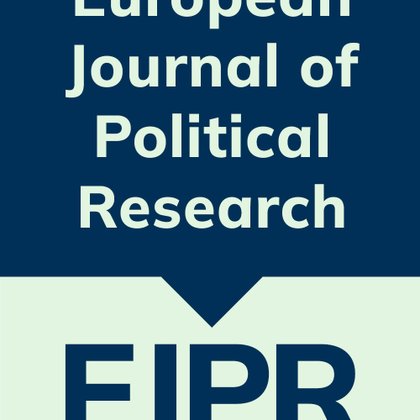
Semih Çakır
@mascakir
Followers
1K
Following
4K
Media
291
Statuses
5K
Political scientist at @univienna. Ph.D. @SciencePo_UdeM - I study polarisation, partisanship and democratic citizenship.
Joined April 2009
Today, I defended my thesis! 🍾 Very grateful to my great advisors @r_dassonneville and @zeynsom and many thanks to @ProfJaneGreen and @m_levendusky for their insightful feedback. I am so excited to continue at @univienna as a postdoc with @MarkusWagnerAT
29
6
178
Full article (OPEN ACCESS): https://t.co/fB32qm0Ate
cambridge.org
Do voters and non-voters differ in their policy preferences?
0
0
1
What's the takeaway? ✅Good news: Voters and non-voters usually share similar policy preferences. ⚠️Bad news: When turnout is low, even small differences can introduce bias. 🗳️Overall: Low turnout isn't always a disaster for this specific question, but it is far from ideal.
1
0
1
When turnout is low, the electorate reflects regular voters' preferences. Higher turnout brings peripheral voters into the mix and reduces this bias. Perpetual non-voters also differ, but they are usually a smaller group, so they introduce less bias overall. 9/10
1
0
1
Moreover, using panel data from the UK (@BESResearch), I examine three voter types: 1️⃣Regular voters: they vote consistently 2️⃣Peripheral voters: they vote intermittently 3️⃣Perpetual non-voters: they almost never vote They differ in their policy preferences. 8/10
1
0
1
Bias that disparities induce ultimately depends on turnout level. Biases are stronger when turnout is lower. This is also why compulsory voting might make sense! 7/10
1
0
1
Nevertheless, when differences *do* emerge, they are not trivial. Using Cohen's d, most significant differences (in black) can be considered small but meaningful. 6/10
1
0
1
But, here's the thing: Disparities are not the norm. At the survey level, voters and non-voters usually hold similar policy views. Most differences are sporadic and do not reach statistical significance. 5/10
1
0
1
In pooled analysis, voters are: ⚪️more right-wing ⚪️less supportive of redistribution ⚪️more supportive of state intervention and spending ⚪️less supportive of same-sex marriage ⚪️more restrictive on immigration ⚪️favor restricting privacy for safety more ⚪️more pro-EU 4/10
1
0
1
Using data from 29 European democracies, I examine differences across the left-right spectrum, economic issues (redistribution, state intervention, spending), social issues (immigration, same-sex marriage, environment, and civil liberties), and European integration. 3/10
1
0
1
First, why do we care? Turnout has declined across democracies. If voters and non-voters have different policy preferences, then low turnout means elections may not accurately represent what the broader public wants. This would be problematic for representation. 2/10
1
0
1
Do policy preferences of voters and non-voters differ in European democracies? My new article in @EJPRjournal finds: Yes, sometimes, but this is not the norm. Let's break it down. 🧵 1/10
2
2
7
Happen to see that the openly gay leader of the D66 party is likely to lead the new government in the Netherlands? Curious how citizens evaluate lesbian and gay party leaders? My latest co-authored article exploring this question is now online @BJPolS!
NEW - A Rainbow Ceiling? Sexual Orientation and Party Leader Evaluations - https://t.co/fQqsqGEq4i - @JoeFCozza, @gdilandro, @AndreaAldrich & @zeynsom
#OpenAccess
0
2
11
Very happy to share that this paper from my PhD dissertation is now published in print. It tackles a question central to my research: How much can parties actually shape the opinions of their supporters? Results suggest their leeway might be more limited than often assumed!
🌅📙 64.3 Does elite polarization cause public polarization? 🪢 @mascakir finds when Labour moved left, most voter didn’t follow. Only a few loyal but ideologically distant supporters shifted. #Polarization #UKPolitics 🔗
0
0
7
The lowest point of my research career? Not impostor syndrome. Not rejection letters. Not even Reviewer 2. It’s Qualtrics hiking fees, my uni pulling the plug… and QuestionPro.
0
0
3
Gentrification at its cutest: The cats claimed the shoe rack, displaced crocs and established a luxury nap zone. Zoning laws? Ignored. Rent? Nonexistent. Locals say eviction is unlikely due to overwhelming cuteness.
0
0
1
From our new issue: "Traceability and Mass Policy Feedback Effects" by Brian Hamel (@hamelpolisci). #APSRNewIssue
https://t.co/ovOCTlojjE
0
14
49
From our new issue: "Measurement That Matches Theory: Theory-Driven Identification in Item Response Theory Models" by Marco Morucci, Margaret Foster, Kaitlyn Webster, So Jin Lee, and David Siegel. #APSRNewIssue
https://t.co/YtlpsbK3He
0
12
59
A Tinder Test of Democratic Norms💋 New paper in @The_JOP with Stuart Turnbull-Dugarte. We rely on a visual conjoint experiment, cross-sectional data, & panel data to show that affective polarization drives the normalisation of the far right 🇬🇧🇪🇸 https://t.co/tIG6lKoipM
1
43
161






